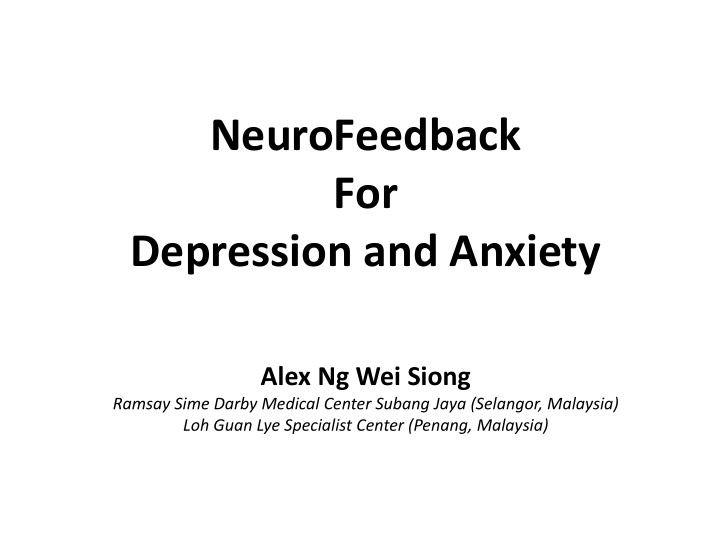



NeuroFeedback For Depression and Anxiety Alex Ng Wei Siong Ramsay Sime Darby Medical Center Subang Jaya (Selangor, Malaysia) Loh Guan Lye Specialist Center (Penang, Malaysia)
Clinical Depression Loss of the ability to experience pleasure Unexplained or prolonged sadness or crying spells Significant changes in appetite and sleep patterns Diurnal variation of mood Irritability, anger, worry, agitation, anxiety Pessimism, indifference A sense of hoplessness/helplessness
Clinical Depression Loss of energy, persistent lethargy, pathological fatigue Feelings of guilt, worthlessness Inability to concentrate, indecisiveness Social withdrawal Difficulty with personal hygiene Unexplained aches and pains May have delusions or hallucinations Recurring thoughts of death or suicide
Clinical Anxiety • Restlessness or feeling keyed-up or on edge • Being easily fatigued • Difficulty concentrating or mind going blank • Irritability • Muscle tension • Sleep disturbance • Although not a diagnostic feature, suicidal ideation and completed suicide have been associated with generalized anxiety disorder
Physical Symptom Indicators • Fatigue • Pain • Sleep disturbances • GI disorders (IBS) – unexplained by medical testing
Atypical Presentations • Anxiety/panic symptoms • Irritability • Hysterical symptoms • Hypochondriacal symptoms • Unexplained pain syndromes • Substance abuse presentations • “Personality disorder”
Slow Waves: Robust Predictable Oscillatory Synchrony • Delta: 1-3 Hz • Theta: 4-7 Hz – Deep Sleep, Repair, – Sleep-wake transitions Problem Solving • Hypnagogic hallucinations • Hypnapompic hallucinations (wake up with the answer!) – Reduced responsiveness to – Creativity, Insight, sensory perturbations – Uncritical acceptance, self- – Predominates during correcting thoughts infancy as connectivity is – Altered States, still weak – Super-learning in young children – Slow wave disorders: foggy thinking, epilepsy, ADHD, coma
Alpha and SMR: Bridging Internal Operations with External Stimuli • Alpha: 8-12 Hz – Calm Alertness, Meditation, Body Awareness, Daydreaming – ‘Reduced during eye movements – More dominant posteriorly, however, years of meditation promotes spread to the pre- frontal cortex…neurofeedback can hasten this process • Coherence, reflection, attunement, integrative thinking • Bottom-Up Processing • Resolution of cognitive dissonance • Sensory Motor Rhythm (SMR) or Mu – 10-15 Hz within sensory-motor strip – Physically Relaxed, Poised for Action, Calm Vigilance
Faster Waves: Interference Prone Complexity • Beta: 13-20 Hz – Focused Thought, Sustained Attention, Industrious Behavior – Characteristics of motor cortices actively engaged in directing movement – Brain is desynchronized due to attending to variety of tasks • High Beta : 21-30 Hz – Hyperalertness, Anxiety…especially if right beta exceeds left beta
Specific Higher Executive Functional Area (reversed) • Feelings of sadness, emptiness or unhappiness • Angry outbursts, irritability or frustration, even over small matters • Loss of interest or pleasure in normal activities, such as sex • Sleep disturbances, including insomnia or sleeping too much • Tiredness and lack of energy, so that even small tasks take extra effort • Changes in appetite — often reduced appetite and weight loss, but increased cravings for food and weight gain in some people
Cont… • Anxiety, agitation or restlessness — for example, excessive worrying, pacing, hand-wringing or an inability to sit still • Slowed thinking, speaking or body movements • Feelings of worthlessness or guilt, fixating on past failures or blaming yourself for things that are not your responsibility • Trouble thinking, concentrating, making decisions and remembering things • Frequent thoughts of death, suicidal thoughts, suicide attempts or suicide • Unexplained physical problems, such as back pain or headaches
Clinical Reports – Depression with Anxiety Disorder • Treated 50 subjects with moderate depressive disorder with Mild to Moderate Anxiety Symptoms • Train on C4 SMR vs C3 SMR vs Cz SMR • Sustained remission of the depression in all 50 subjects in 20 sessions • All reduced or discontinued medication
Take Home Points • Neurofeedback is biofeedback for the Central Nervous System – Targets firing patterns (brain rhythms) and regional blood flow • Brain rhythms correspond to certain behavioral and cognitive states • Cortical brain rhythms are detectable non-invasively (EEG) • As the EEG inclines towards a desired frequency, a rewarding stimulus is applied • The stimulus is auditory and/or visual
? ? ? ? ? ? ? ?
Recommend
More recommend